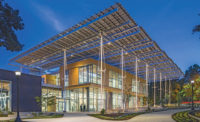The town already includes Korea's first LEED-certified school, a 100-acre central park with a navigable canal fed by seawater, South Korea's first nonsmoking hotel, a golf course and the first phase of Asia's first LEED-certified convention center. Further, the plan for the built-out Songdo IBD calls for one of the world's largest pneumatic waste-collection systems.
Plans call for buildings containing a total of 100 million sq ft, including 40 million sq ft of office space, 35 million sq ft of residential space, 10 million sq ft of retail, 5 million sq ft of hotel space and 10 million sq ft of public space.
The city currently has 22,000 residents, with 5,000 more expected by the end of next year. It is serviced by bus lines, subways, water taxis and bikeways. Songdo IBD is planned for a daytime commuting population of 300,000 and a resident population of 65,000.
Changing Practice
In Gale's world, technology is no longer an afterthought. "We consistently advise that technology is the fourth utility—in addition to water, waste and energy—and is a crucial and fundamental element to ensure the environmental responsibility and economic success of the city," says Murcott.
To fully integrate technology into projects, Gale has introduced a new member to its planning and design teams: information and communications technology (ICT) system planners. "The enabling technologies need to be baked into the master plan and initial design and development planning from the get-go, rather than as a follow-on," adds Murcott.
"Technology is influencing how you think; it embeds itself as another thing that gets coordinated with an overall plan," says James von Klemperer, a KPF principal. That coordination is refreshing for Anil Menon, the Bangalore, India-based president of the Smart+Connected Communities initiative of Cisco, a building managed-services provider. Cisco started collaborating with Gale's planners in 2008.
"This is the first time we are working with a developer to rethink how a city was going to be designed, built and, more importantly, operated," says Menon. "Our ICT master-plan experts literally intertwined with Gale's team to think how buildings could be a little more smart."
In July, Cisco and NSIC announced that Cisco would be investing $47 million in U.Life Solutions as a partner to Songdo U.Life LLC, a company previously formed by NSIC and LG CNS, a Seoul-based information technology service provider. Under the agreement, Songdo U.Life will retain majority ownership in U.Life Solutions.
Using U.Life, NSIC will integrate Cisco products and related technologies into remaining Songdo IBD projects. This includes managed smart-city services to businesses, organizations and residents, such as integrated building and facilities management, on-premise safety and security, home networking, video telepresence and virtual concierge services. U.Life will deliver services and applications to end users over Cisco's Unified Service Delivery platform, an integrated solution unifying data centers, computing resources, video, collaboration and communications.
Gale, chairman of the firm, had his vision for ubiquitous technology in place from the genesis of Songdo IBD's master-planning process more than 10 years ago. But the vision was ahead of the market's ability to realize it. In 2006, the developer consulted several firms about the U.Life concept, including Cisco. Still, none could provide the end-to-end solution.









Post a comment to this article
Report Abusive Comment